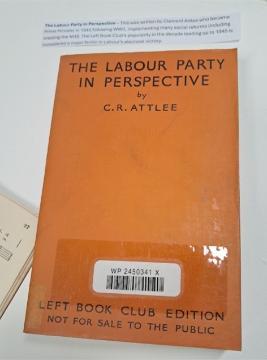Left Book Club

We are delighted to have a fairly comprehensive collection of the Left Book Club books published between 1936-1948 in the library.
The Left Book Club was one of the first monthly book subscription services in the UK. Members received a hand selected title each month which had “not for sale to the public” printed on their front covers marking them as an exclusive product. The publishers sought to promote left wing politics within the UK during its run from 1936 until 1948. It was founded by Victor Gollancz with the stated aim to "help in the struggle for world peace and against fascism”. It proved to be popular, reaching 40,000 subscribers by the end of its first year active, and peak membership was 57,000 in 1939, making it a means of mass dissemination of leftist ideals.
The books themselves covered a range of topics, from history to current affairs and politics to science, and even fiction, but what united them was the left-hand politics infused in the outlook of every title. They published both their own works which would only be available to members and reprints of notable socialist texts or polemics by socialist authors.
The Left Book Club is an important part of British history providing an interesting insight on the politics of the time. A number of the books in the collection are also written by notable members of the labour party.
Even though the club was proudly left wing, there were still several clashes as different opinions on communism, socialism, class relations and mainstream politics came into play. As any student of twentieth century politics knows, there were a myriad of left and left-ish positions which were often in conflict with one another and some of these disputes can be seen in the publication choices and controversies of the Left Book Club.
This is most visible when considering the clubs relation to the Soviets. In the initial phase of the club, many members and authors were openly communist, and were key proponents of Soviet Russia in the UK. There was occasionally pushback, as Gollancz wanted to keep the club aligned with the Labour party (of which he was a member) and so would try and distance the club from campaigns the Labour party disapproved off, which at sometimes would clash with its communist members. However, Gollancz also failed to publish Trotskyist writings that were critical of the Soviet Union and the direction it was going under the rule of Stalin. Ultimately the club did make a break with the Communist party in 1941, which Gollancz laid out in ‘Betrayal of the left’ (including the Soviet-Nazi non-aggression pact of 1939 indicating that the Soviets were not as dedicated anti-fascists as Gollancz wanted), but its early relationship with the Soviet Union is unclear still.
Despite these conflicts and controversy, the Left Book Club was a important social and political phenomenon. The influence and popularity of the Left Book Club appears to have been not inconsiderable. A number of authors and members were noted members of the Labour party, including future Prime Minister Clement Attlee. Many argue that the election victory of Attlee and the Labour party in 1945 may have been due to the Left Book Club popularising many socialist ideals which the party went on to enact. It also prompted the establishment of more political subscription book clubs – notably its political rival Right Book Club, but also a Liberal book club and Peace book club.

We are delighted to have such a comprehensive collection of the Left Book Club at Wolverhampton and encourage staff, students and researchers to ask us about using the collection.
For more information please contact the Corporate Communications Team.


/prod01/wlvacuk/media/departments/digital-content-and-communications/submitted-news-images/Smelting-knife.png)
/prod01/wlvacuk/media/departments/digital-content-and-communications/images-2024/250630-SciFest-1-group-photo-resized-800x450.png)
/prod01/wlvacuk/media/departments/digital-content-and-communications/submitted-news-images/Way-youth-zone-August.JPG)
/prod01/wlvacuk/media/departments/digital-content-and-communications/submitted-news-images/Muslim-woman-playing-football.jpg)
/prod01/wlvacuk/media/departments/digital-content-and-communications/submitted-news-images/Business-School-800x450.jpg)
/prod01/wlvacuk/media/departments/digital-content-and-communications/submitted-news-images/University-of-the-Year.jpg)